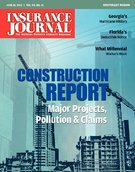Eighteen coastal states permit insurers to use hurricane deductibles in their homeowners policies. But the Insurance Information Institute is concerned insureds may not see them even though they are clearly listed on their policies or understand them since they may be calculated in a different fashion than their other deductibles. As the hurricane season gets underway, many homeowners could use a reminder to locate and read their policies.
The coastal states that allow insurers to incorporate hurricane deductibles are Alabama, Connecticut, Delaware, Florida, Georgia, Hawaii, Louisiana, Maine, Maryland, Massachusetts, Mississippi, New Jersey, New York, North Carolina, Rhode Island, South Carolina, Texas and Virginia.
While standard homeowners deductibles are usually a flat dollar amount, such as $500 or $1,000, hurricane deductibles are generally calculated as a percentage and typically vary from 1 to 5 percent of a home’s insured value. So, if a home is insured for $300,000 and the policy on the structure has a 5 percent deductible, the first $15,000 of a claim must be paid by the policyholder in the event there is a windstorm or hurricane strong enough to meet the hurricane deductible threshold.
The triggers for hurricane deductibles vary by state and by insurer and usually apply when the National Weather Service names a tropical storm, declares a hurricane watch or warning, or defines a hurricane’s intensity.
In some states, coastal policyholders may have the option of paying a higher premium in return for a traditional dollar deductible. In high-risk coastal areas, insurers often require the inclusion of a hurricane deductible before selling a homeowners insurance policy.
III reminds us when and why hurricane deductibles came on the scene.
In 1992, Hurricane Andrew caused $15.5 billion insured losses, making it the most expensive storm ever for insurers, with claims costing nearly four times as much as 1989’s Hurricane Hugo. It soon became apparent through an assessment of catastrophe-risk computer modeling, and residential development patterns, that home insurers were far more vulnerable to significant weather-related claims payouts than they had previously thought. Some of the largest insurers, for example, found it difficult to secure the reinsurance coverage they needed to protect their bottom line because reinsurers were unwilling to assume so much risk. To get coverage from reinsurers, insurers agreed to reduce greatly their potential maximum claims payouts from hurricanes by requiring their policyholders to bear a greater share of the cost.
It’s a good time to remind policyholders about the share of hurricane losses that is their own.
Topics Catastrophe Carriers Hurricane Homeowners
Was this article valuable?
Here are more articles you may enjoy.


 A $29 Billion Weed Market Fights to Diversify Amid Legal Hurdles
A $29 Billion Weed Market Fights to Diversify Amid Legal Hurdles  Big ‘I’ Report: Independent Agency Channel Placed 62% of Premiums in 2023
Big ‘I’ Report: Independent Agency Channel Placed 62% of Premiums in 2023  Ford Recalls 668,000 2014 F-150 Pickup Trucks Over Transmission Issue
Ford Recalls 668,000 2014 F-150 Pickup Trucks Over Transmission Issue  Three Charged With Helping Agents Cheat on Florida Insurance License Exams
Three Charged With Helping Agents Cheat on Florida Insurance License Exams 


